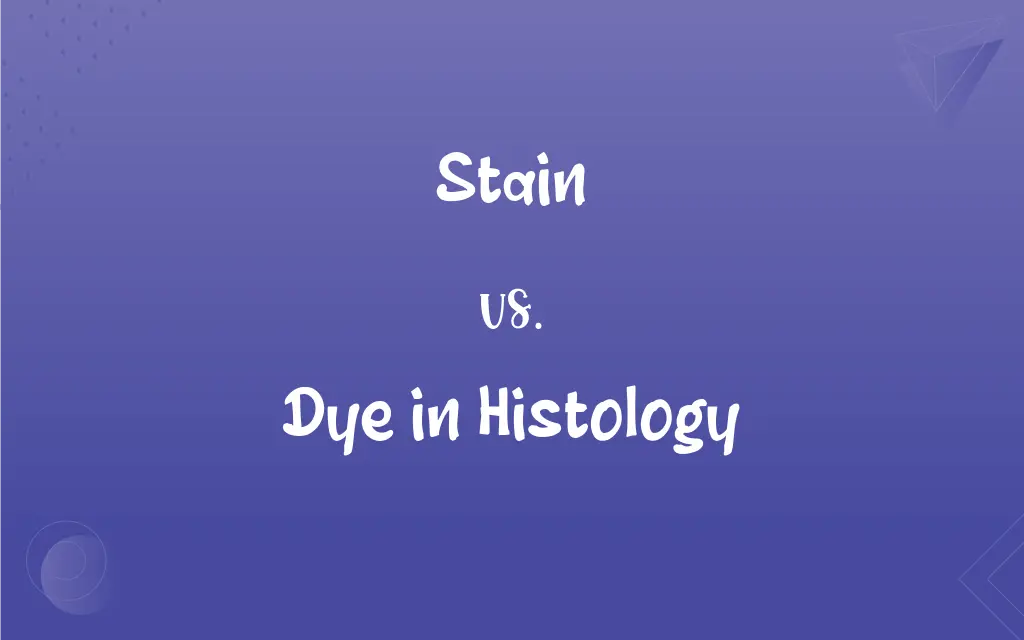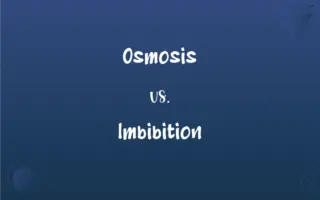Stain vs. Dye in Histology: What's the Difference?
Edited by Aimie Carlson || By Harlon Moss || Updated on October 18, 2023
In histology, a stain is the process of coloring tissues, while a dye is the coloring agent used.

Key Differences
Within the specialized field of histology, both stain and dye play pivotal roles in unveiling the minute details of biological tissues. Stain refers to the procedure or method employed to color tissues, ensuring their microscopic structures are highlighted and distinguishable. Conversely, dye in histology represents the actual coloring agent — the substance that, when applied, binds to different tissue components, rendering them visible under microscopic examination.
Further delving into the nuances of histology, staining is an indispensable tool that accentuates the differences in biological tissues. While stain focuses on the act or technique of adding color to samples, dye pertains to the physical matter — the variety of colored substances that impart specific shades to these tissues. The specificity of dyes is of utmost importance; different dyes have affinities for different biological structures, ensuring a clear and distinct visualization.
To comprehend this differentiation, imagine the process of painting a canvas. The act of applying color can be compared to staining, while the actual paint parallels the dye. Just as the choice of paint can alter the artwork's appearance, the choice of dye can significantly impact the clarity and detail of a histological sample.
It's worth noting the symbiotic relationship between stain and dye in histology. While distinct in definition, one cannot function effectively without the other. Staining processes require appropriate dyes to be successful, and dyes need a method of application — staining — to be of any use in histological examinations.
Comparison Chart
Definition
The method of coloring tissues.
The coloring agent used in the process.
ADVERTISEMENT
Focus
Technique or procedure.
Material or substance.
Application
Applied through a process.
Applied as a substance.
Interaction with Tissues
Highlights structures.
Binds to specific molecules in the tissues.
Utility
Dependent on the choice of dye.
Determines specificity of staining results.
Stain and Dye in Histology Definitions
Stain
A mark or discoloration.
The wine left a stain on the carpet.
ADVERTISEMENT
Dye in Histology
A soluble compound used to color tissues.
The dye helped differentiate between the muscle fibers.
Stain
A coloring agent or solution.
We used a special stain to highlight the bacteria.
Dye in Histology
A chemical that binds to molecules, highlighting them under a microscope.
This dye reacts with proteins, making them easier to study.
Stain
An indication of damage or discredit.
The scandal was a stain on the organization's reputation.
Dye in Histology
A coloring substance used in histological procedures.
The scientist selected a specific dye to view the cell nucleus.
Stain
A moral blemish or bad reputation.
His actions left a stain on his character.
Dye in Histology
A staining agent with an affinity for specific biological components.
The chosen dye binds exclusively to DNA strands.
Stain
A chemical used to color tissues for microscopic study.
We introduced the stain to the slide to view the cells.
Dye in Histology
A colored substance aiding in the visualization of microscopic structures.
With the help of the dye, the neuronal connections became clear.
Stain
To discolor, soil, or spot
The spilled juice stained the carpet.
Stain
To bring into disrepute; taint or tarnish
The scandal stained the mayor's reputation.
FAQs
Can you stain tissues without dye?
No, staining requires a dye to impart color to the tissues.
What is a stain in histology?
A stain is the process or method used to color biological tissues for microscopic study.
Why is staining important in histology?
Staining enhances contrast in tissues, making microscopic details visible.
How is a dye used in histology?
A dye is the coloring agent applied to tissues, allowing specific structures to be visible under the microscope.
Do dyes always give the same color in all tissues?
No, the resulting color can vary based on the tissue type and the dye's chemical properties.
Can a single tissue sample be stained with multiple dyes?
Yes, multiple dyes can be used sequentially or in combination to highlight different tissue components.
Is the staining process harmful to tissues?
While staining can alter tissues, the changes are generally acceptable for histological study.
Can staining techniques be automated?
Yes, there are automated staining machines that can process multiple samples consistently.
What's the difference between a stain and a dye in histology?
A stain refers to the coloring process, while a dye is the coloring agent used.
Are there natural dyes used in histology?
Yes, some natural substances can be used as dyes in histological procedures.
Are all dyes suitable for every tissue type?
No, certain dyes have specific affinities for particular tissue components.
How long does the staining process take?
It varies based on the stain and tissue type, but it can range from minutes to hours.
How is the choice of dye determined for staining?
The choice is based on the tissue type and the specific structures one aims to visualize.
What happens if a wrong dye is used in staining?
Using an inappropriate dye might not yield the desired contrast or clarity under the microscope.
Why are some dyes more preferred than others in histology?
Certain dyes provide clearer, more distinct results for specific tissue structures.
Is staining a permanent change to the tissue?
No, some stains can be washed out, while others bind more permanently.
How do dyes bind to tissues?
Dyes can bind chemically or physically, depending on their properties and the tissue component they have an affinity for.
How are stain and dye chosen for a particular study?
It's based on the tissue's nature, the structures of interest, and the desired visual outcome.
Do stains and dyes have other applications outside histology?
Yes, they can be used in various fields like microbiology, textile industries, and art.
Is it essential to use fresh dyes for staining?
Yes, to ensure optimal results, dyes should be of good quality and not expired.
About Author
Written by
Harlon MossHarlon is a seasoned quality moderator and accomplished content writer for Difference Wiki. An alumnus of the prestigious University of California, he earned his degree in Computer Science. Leveraging his academic background, Harlon brings a meticulous and informed perspective to his work, ensuring content accuracy and excellence.
Edited by
Aimie CarlsonAimie Carlson, holding a master's degree in English literature, is a fervent English language enthusiast. She lends her writing talents to Difference Wiki, a prominent website that specializes in comparisons, offering readers insightful analyses that both captivate and inform.































































